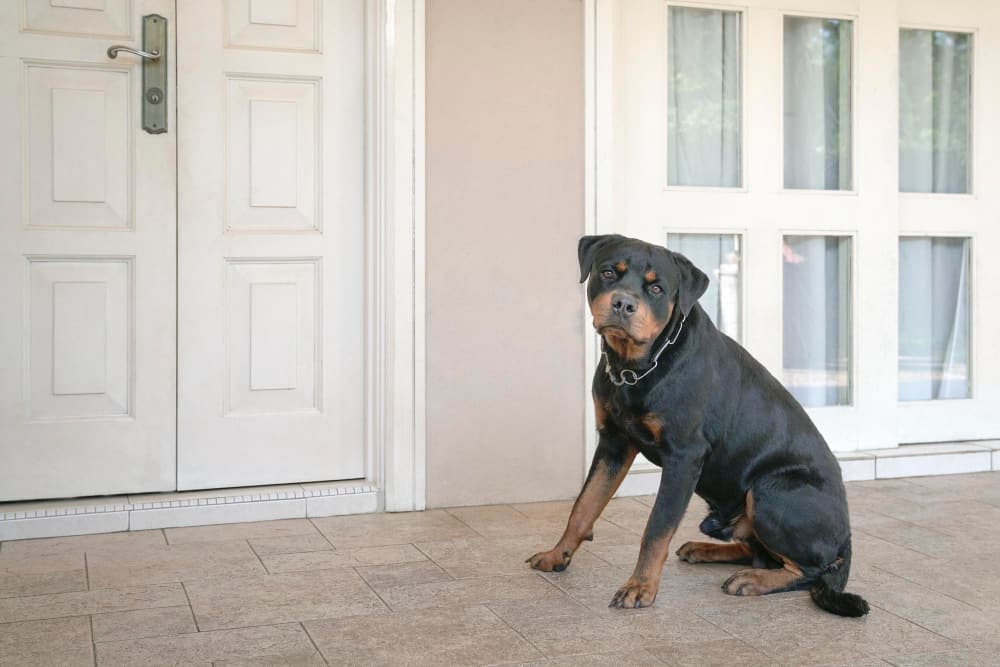Stop Your Dog From Barking at the Doorbell: Effective Training Tips

Are you tired of your pup going bonkers whenever someone knocks or rings the doorbell? It’s like a scene out of Old MacDonald’s farm with all that barking! But fear not, because we’ve got the solution to your noisy problem.
In this guide, we’ll show you how to train dog not to bark at door to keep calm and quiet when someone’s at the door. From simple commands like ‘leave’ and ‘in’ to get some backup from friends or family, we’ll walk you through step-by-step instructions on how to make your pup chill out.
We’ll also dive into why dogs bark at the door, quick fixes for their anxiety, and the importance of long-term training. So get ready to transform your home into a peaceful haven for you and your furry friend. Let’s get started!
Contents
- Key Takeaways
- How to train dog not to bark at door
- Distract your dog
- Understand the Trigger
- Use Positive Reinforcement
- Teach the “Quiet” Command
- Reward Calm Behavior
- Train your dog to a designated spot or use a mat when someone is at the door.
- Treat the door (or your visitors) like any other distraction
- Take it outside
- Choosing The Right Breed
- Avoid Punishment
- Practice Controlled Door Encounters
- Provide Mental Stimulation
- Seek Professional Help if Needed
- How do I stop territorial barking?
- How do I stop territorial barking at night?
- What are some other reasons why dogs bark
- Conclusion
Key Takeaways
- Use the ‘leave’ command to establish control over the dog’s behavior.
- Teach the dog the word ‘in’ and use hand direction to guide them to their bed or designated area.
- Reward the dog with praise or kibble when they follow the ‘in’ command.
- Enlist help from friends or family to practice the commands and rewards.
How to train dog not to bark at door

If you’re tired of your dog barking at the door, you can try several effective methods.
One approach is to distract your dog with a toy or treat when someone approaches the door, redirecting their attention away from barking.
Understanding the trigger for their barking, excitement, or fear can help you address the issue.
Positive reinforcement, such as rewarding calm behavior and teaching the ‘quiet’ command, can further discourage your dog from barking at the door.
Distract your dog
A simple distraction technique is one effective way to stop your dog from barking at the door. When your dog starts barking at the doorbell or knocks, try the following methods to redirect their attention:
- Use a treat-dispensing toy: Fill a toy with your dog’s favorite treats and give it to them when the doorbell rings. This will engage their senses and redirect their focus away from barking.
- Provide a safe space: Create a designated area, such as a crate or a comfortable bed, where your dog can go when they feel anxious or excited. Teach your dog to associate this space with positive experiences, like treats or calming music.
- Engage in an alternative behavior: Train your dog to perform a specific command, such as sitting or lying down, when the doorbell rings. This will redirect their energy and help them stay calm.
- Use background noise: Play calming music or turn on a white noise machine to drown out the doorbell sound. This can help reduce your dog’s sensitivity to the doorbell and minimize their barking.
Understand the Trigger
To stop your dog from barking at the door, understand the trigger by identifying the cues that cause them to react. One common trigger is the sound of the doorbell ringing. Dogs instinctively respond to this sound, perceiving it as a potential threat or intruder alert. Other triggers may include seeing someone approaching the door or the sound of footsteps outside. By recognizing these triggers, you can effectively train your dog to remain calm and quiet when faced with them.
| Trigger | Examples |
|---|---|
| Doorbell | The sound of the doorbell ringing |
| Barking | When your dog reacts by barking |
| Dog | Your furry friend who needs training |
Understanding the specific triggers that cause your dog to bark at the door is the first step in addressing the behavior. Once you have identified these triggers, you can implement appropriate training techniques to modify your dog’s response.

Use Positive Reinforcement
To stop your dog from barking at the door, reinforce positive behavior using rewards. Training your dog not to bark requires patience and consistency. Here are some steps you can take to teach your dog to stop barking at the door:
- Train your dog to associate the door with positive experiences. Use treats or praise when your dog remains calm near the door.
- Use the ‘quiet’ command to teach your dog to stop barking on command. Reward your dog when they respond appropriately.
- Practice simulated doorbell sounds and reward your dog for not reacting. Gradually increase the intensity of the sound to desensitize your dog.
- Praise your dog for quiet behavior and reward staying calm when someone arrives at the door.
Teach the “Quiet” Command
To teach your dog to stop barking at the door, you can start by teaching them the ‘Quiet’ command. This command will help your dog learn to stay calm when the doorbell rings and prevent them from barking excessively. Teaching your dog an alternative behavior can redirect their attention and create a more peaceful environment. Here is a table to help you understand the steps to teach the ‘Quiet’ command:
Steps to Teach ‘Quiet’ Command
Wait for your dog to bark at the door.
- Say “Quiet” in a firm but calm voice.
- Immediately reward your dog with a treat or praise when they stop barking. |
Repeat this process multiple times, gradually increasing the duration of silence before rewarding. - Practice in different situations, such as when the doorbell rings or when someone knocks on the door.
Reward Calm Behavior
Use treats or praise to reward your dog’s calm behavior when they aren’t barking at the door. By rewarding calm behavior, you can reinforce the desired response and encourage your dog to remain quiet when the doorbell rings.
Here are four steps to help you reward your dog’s calm behavior and stop them from barking at the door:

- When the doorbell rings, redirect your dog’s attention to a designated area or command, such as ‘sit’ or ‘stay.’ Reward them with a treat or praise when they follow the command and remain calm.
- Use positive reinforcement techniques consistently to reinforce the desired behavior. Give treats or praise immediately after your dog is calm and quiet. This will help them associate calmness with rewards.
- Practice regular training sessions where you simulate doorbell ringing and reward your dog for staying calm. Gradually increase the distraction and duration of calmness before giving the reward.
- Be patient and consistent in your training. It may take time for your dog to learn to stay calm when the doorbell rings. Remember to reward your dog only when they’re calm, as this will reinforce the desired behavior.
Train your dog to a designated spot or use a mat when someone is at the door.
When someone is at the door, teach your dog to go to a designated spot or use a mat to prevent barking. This helps to redirect their attention and keep them calm.
Start by choosing a specific spot or mat where you want your dog to go when someone is at the door. Use positive reinforcement techniques such as treats or praise to encourage them to go to that spot.
Practice this behavior regularly, gradually increasing the level of distractions. When someone is at the door, give your dog the command to go to their designated spot or mat. Reward them when they follow the command and remain calm.
With consistency and patience, you can train your dog to stop barking when someone is at the door and instead go to their designated spot.
Treat the door (or your visitors) like any other distraction
Treat the door (or your visitors) as you’d any other distraction when training your dog to stop barking at the door. Treating the door or your visitors as distractions can help your dog learn to remain calm and quiet when the doorbell rings, or someone knocks. Here are some steps to follow:
- Use the ‘leave’ command to establish control over your dog’s behavior.
- Teach your dog the word ‘in’ and guide them to their designated area.
- Reward your dog with praise or treats when they follow the ‘in’ command.
- Practice the commands and rewards multiple times with the help of friends or family members.
Take it outside
To stop your dog from barking at the door, start by taking the training outside. This will help your dog generalize the behavior and understand that the command applies in any setting. Use the same techniques and commands as indoors to maintain consistency. One effective way to engage your audience in this training is by using a table to outline the steps and rewards. Here is an example:
| Step | Command | Action | Reward |
|---|---|---|---|
| 1 | “Leave” | Point to designated area | Praise or treat |
| 2 | “Sit” | Ask the dog to sit | Praise or treat |
| 3 | “Quiet” | Use a calm voice | Praise or treat |
| 4 | “Good” | Reward for quiet behavior | Praise or treat |
Remember to be patient and consistent with your training. With time and practice, you can teach your dog to stop barking at the doorbell and be quiet when visitors arrive.

Choosing The Right Breed
Choose a breed known for being calm and less prone to barking at the door. Not all dog breeds have the same tendencies regarding barking at the door. By selecting a naturally less vocal breed, you can reduce the chances of your dog barking every time the doorbell rings or someone approaches the door.
Here are four breeds that are typically calm and less prone to barking at the door:
- Basset Hound: These dogs have a laid-back personality and aren’t known for excessive barking.
- Cavalier King Charles Spaniel: They’re friendly, gentle dogs that usually don’t bark excessively.
- Newfoundland: These giant dogs are known for being calm and quiet, making them a good choice for reducing barking at the door.
- Great Dane: Despite their size, Great Danes are generally calm and not prone to excessive barking.
Avoid Punishment
You should never punish your dog for barking at the door. Punishment can create fear and anxiety, making the problem worse. Instead, focus on positive reinforcement and redirection techniques. One effective method is teaching your dog an alternative behavior, such as going to bed when they hear the doorbell. Use the following table as a guide to understand why dogs bark at the doorbell and how to react to their behavior:
| Dog Behavior | How to React |
|---|---|
| Bark at the door | Redirect their attention to a designated spot or use a command like “quiet” or “enough.” |
| Dogs bark at the doorbell | Teach an alternative behavior, such as going to their bed, and reward them for following the command. |
| Dogs bark at the doorbell. | Use positive reinforcement and reward them for remaining calm when the doorbell rings. |

Practice Controlled Door Encounters
Practice controlled door encounters by implementing a structured routine to prevent your dog from barking at the door. Here are four steps to help you train your dog to be calm when someone comes to the door:
- Ask your dog to sit: Teach your dog the command to sit and practice it regularly. When someone comes to the door, ask your dog to sit before opening it. This will help your dog learn to stay calm and focused.
- Associate the doorbell: Use a doorbell sound or mat to simulate someone at the door. When the doorbell rings, ask your dog to sit and reward them for staying calm. This will help your dog associate the doorbell with a calm reaction.
- Reward calm behavior: When your dog remains calm as someone approaches the door, reward them with treats or praise. This positive reinforcement will reinforce the desired behavior and encourage them to stay calm in future door encounters.
- Practice consistently: Repeat these door encounters regularly to reinforce the training. Consistency is key for your dog to learn and maintain the desired behavior. With practice, your dog will learn to stay calm and not bark at the door when someone arrives.
Provide Mental Stimulation
Incorporate interactive toys and puzzles into their daily routine to provide mental stimulation for your dog and prevent them from barking at the door.
When your dog is barking because someone comes to the door, it may be a sign that they’re bored or lacking mental stimulation. Interactive toys and puzzles can help engage their mind and keep them occupied, reducing their desire to bark.
These toys can include treat-dispensing toys, puzzle games, or even hide-and-seek activities. By providing your dog with these mental challenges, you can help them expend their energy and focus their attention on something positive.
This will help prevent excessive barking at the door and promote overall mental well-being for your furry friend.
Seek Professional Help if Needed
If you’re struggling to stop your dog from barking at the door, consider seeking professional help from a qualified dog trainer or behaviorist. They have the knowledge and expertise to address this issue effectively.
Here are some reasons why professional help may be beneficial:
- Expertise: Professional dog trainers have extensive knowledge and experience understanding canine behavior and implementing effective training techniques.
- Tailored Solutions: A professional can assess your situation and provide personalized training plans to address your dog’s barking at the door.
- Efficient Training: With professional guidance, you can learn the most efficient and effective ways to train your dog, saving you time and frustration.
- Addressing Underlying Issues: A professional can identify any underlying issues contributing to your dog’s barking and provide strategies to address them.
How do I stop territorial barking?
To stop territorial barking, establish clear boundaries and train your dog to respond to specific commands when someone approaches your property. By setting these boundaries, you can teach your dog not to bark at every little sound, whether someone is knocking on the door or ringing the doorbell. Use the following table to understand how to address territorial barking:
| Commands | Action | Purpose |
|---|---|---|
| “Quiet” | Stop barking | Teach your dog to be silent |
| “Leave it” | Ignore | Prevent your dog from reacting |
| “Go to bed” | Go to a spot | Redirect your dog’s attention |
| “Stay” | Stay in place | Keep your dog calm and still |
How do I stop territorial barking at night?
When addressing territorial barking, it’s important to consider how to stop the behavior at night. Here are four effective strategies to help you achieve a peaceful night’s sleep:

- Manage the environment: Minimize external stimuli that trigger barking by closing curtains or blinds. Use white noise or calming music to drown out sounds that may provoke your dog.
- Establish a bedtime routine: Create a consistent routine that includes exercise and mental stimulation before bedtime. A tired dog is less likely to engage in excessive barking.
- Provide a safe and comfortable sleeping area: Ensure your dog has a cozy and secure space to sleep, such as a crate or designated bed. This can help alleviate anxiety and reduce barking.
- Training and desensitization: Gradually expose your dog to nighttime noises, such as knocking or ringing the doorbell, during the day. Reward calm behavior and gradually increase the intensity of the stimuli.
What are some other reasons why dogs bark
Dogs bark commonly due to their need for attention or communication. Dogs are social animals and use barking to interact with their dog owners and other animals.
Here are some other reasons why dogs bark:
- Alarm or alert: Dogs have an instinct to protect their territory, so they may start barking when they hear unfamiliar noises or see strangers approaching. This is their way of warning you about potential threats.
- Fear or anxiety: Dogs may start barking when they feel scared or anxious. It could be triggered by loud noises, unfamiliar situations, or being left alone. They use barking as a way to cope with their fear or anxiety.
- Boredom or frustration: Dogs need mental and physical stimulation, and if they don’t get enough, they may start barking out of boredom or frustration. Keeping your dog mentally and physically active can help reduce excessive barking.
- Attention-seeking: Some dogs learn that barking gets them attention from their owners. If your dog starts barking to get your attention, teaching them alternative ways to communicate their needs is important.
Understanding why dogs bark can help you address the underlying cause and find appropriate solutions.
Conclusion
In conclusion, how to train dog not to bark at door is possible with the right techniques and consistency. You can create a calm and peaceful environment when visitors arrive by teaching them commands like ‘leave’ and ‘in’ and providing them with alternative behaviors.
Remember to address any underlying anxiety or territorial issues and seek professional help if needed. You can create a harmonious home for you and your furry friend with patience and commitment.






